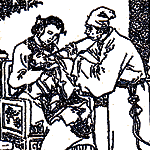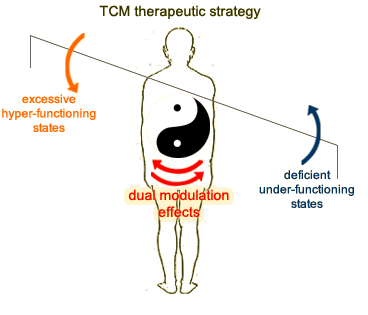Traditional Chinese Medicine Theory and Immunity
 |
| The variolation method in ancient times: the patient inhales the vaccine powder through the nose with the aid of a silver tube. |
In the history of traditional Chinese medicine (TCM), the documentary records for the Chinese word "immune" was first seen in the 18th century in the book Mian Yi Lei Fang (Formulas for the Immunity from Plague). "Plague" had been a common term used by ancient Chinese to refer to infectious diseases that affected a large population. Although the terminology came later than Western medicine, their concrete context was different. However, TCM already knew about the theory and practice of immunology and infectious diseases from earlier dynasties. In chapter 72 of the Suwen (The Book of Plain Questions), when the Yellow Emperor asked about the seasonal epidemic diseases, his chief advisor Qi Bo answered that in order to defend against those diseases, one should always keep his healthy energy abundant, and the evils will not invade. The dialogue clearly shows that TCM regards "healthy energy" as the general defense mechanism against infectious diseases. Since then, it has abundant experience in various related aspects, with studies concentrating on wenbing, shanghan, liqi (pestilential evils) and measures of variolation (inoculation against smallpox) in the 16th century which was very progressive for the time.
TCM immunology has its own unique characteristics listed below:
The concept of holism is a main characteristic of TCM immunology.
From the beginning, TCM has employed holistic approaches; because, it sees the human body as an organic whole. The correlations between the organs and tissues, as well as the human person and the living environments, are organized according to specific orders, which give rise to mutual balance between each physiological function. This integral stability and harmony is the root of disease defense and health maintenance. Any disturbances in this equilibrium will cause disease. Every part of the body such as qi (vital energy), blood, body fluids, organs and the meridians has its own particular function. They combine to build up the body's defense system and bring out their protective strength mutually. According to TCM concepts, the body's natural resistance against diseases and its repair ability are described as a flow of energy that circulates throughout the body, which is called the healthy energy (zheng qi).
Healthy energy (zheng qi) is the integral manifestation of the human body's immune functions.
Under normal circumstances, the body depends on the immune system to fight against various infections and to clear up harmful materials in order to keep a clean internal environment. When the immune system functions normally, health can be maintained; otherwise disharmony will occur and give rise to illness.
Similar to Western medicine, TCM also holds that the body has its own disease defense ability due to the existence of healthy energy (zheng qi). In chapter 72 of Suwen (The Book of Plain Questions), it states: "When healthy energy is well stored inside the body, no evils can cause interference." In chapter 33 it states: "Whenever the evils are gathered inside, a deficiency of healthy energy must be present." These statements imply that healthy energy is the body's natural resistance against disease, and disease is seen as the result of the disharmonious healthy energy within us. Occasionally, other TCM terms such as primordial qi, genuine qi or protective qi also refer to this kind of resistance. All of these embody the body's comprehensive immune functioning.
Immune modulation effects are an important part of immune functioning.
TCM holds that when healthy energy (zheng qi) is abundant, evil forces cannot prevail. According to the yin yang theory, the body's yin and yang are regulated and adjusted continuously. Keeping yin and yang in equilibrium is an essential factor to carry on normal life activities. Once this equilibrium is disturbed, disease will result.
Resuming yin and yang harmony is the universal treatment goal of TCM. The overall therapeutic strategy is to replenish deficiencies and remove excesses of yin or yang. The approaches are usually focused on holistic regulation and possession of dual modulation effects, which as stated above, are to remove excesses and replenish deficiencies. These characteristics are similar to Western medicine's understanding of our body's immune modulation effects. The dual modulation (or immune modulation) effects of TCM have the following characteristics.
 |
TCM focuses on mobilizing our own innate healing power; most of its remedies work on the whole being, not just on specific systems. Their healing power is far beyong the physical level; they can also work on the level of qi (vital energy) that empowers us. Even when the body seems healthy and there are no outward symptoms, immune function can be affected with symptoms present internally. Herbal remedies can find and fix these imbalances even when they are not obvious to us. |
 |
To support the balancing process, TCM uses different modulation methods, for example adjusting the body's yin and yang, qi (vital energy), blood or organ functions. They can rehabilitate the body to go from a hyper-functioning state to a normal state or from an under-functioning level back to a normal state. TCM has unique theories about this, categorizing the regulating properties into four actions; "to depress when stimulated", "to rise when collapsed", "to subdue when overwhelming" and "to nourish when deficient." |
 |
In some ways, normal immune functions are enhanced and the internal pathogenic factors are eliminated with dual modulation effects. A complementary relationship is formed that reinforces healthy energy and repels evils. |
 |
| TCM therapeutic methods are usually focused on holistic regulation and possession of dual modulation effects. |
|